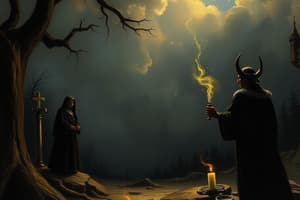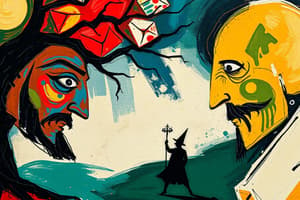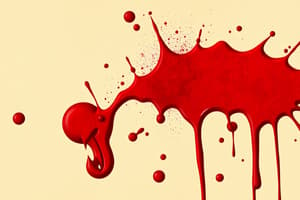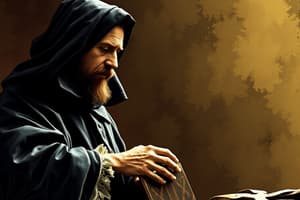Podcast
Questions and Answers
Which of the following are examples of blood imagery in Macbeth? (Select all that apply)
Which of the following are examples of blood imagery in Macbeth? (Select all that apply)
- Murders (correct)
- Lady Macbeth's sleepwalking
- Lady Macbeth cleaning her hands from invisible blood (correct)
- Duncan's horses eating each other
What does the animal imagery in Macbeth include? (Select all that apply)
What does the animal imagery in Macbeth include? (Select all that apply)
- Snake under flower (correct)
- Raven (correct)
- Mountain goat
- Little owl killing big hawk (correct)
Which of the following are examples of sleep imagery in Macbeth? (Select all that apply)
Which of the following are examples of sleep imagery in Macbeth? (Select all that apply)
- Macbeth's armor
- Lady Macbeth sleepwalking (correct)
- Macbeth sleep no more (correct)
- Lady Macbeth's death (correct)
What are examples of light/dark imagery in Macbeth? (Select all that apply)
What are examples of light/dark imagery in Macbeth? (Select all that apply)
What does clothing imagery refer to in Macbeth?
What does clothing imagery refer to in Macbeth?
What are examples of supernatural/black magic references in Macbeth? (Select all that apply)
What are examples of supernatural/black magic references in Macbeth? (Select all that apply)
What do floating daggers symbolize in Macbeth?
What do floating daggers symbolize in Macbeth?
What does mental disease imagery refer to in Macbeth? (Select all that apply)
What does mental disease imagery refer to in Macbeth? (Select all that apply)
What does 'borrowed robes' imply in Macbeth?
What does 'borrowed robes' imply in Macbeth?
What does Birnam Wood symbolize in Macbeth?
What does Birnam Wood symbolize in Macbeth?
What does Macduff's castle represent in Macbeth?
What does Macduff's castle represent in Macbeth?
What is the significance of Macbeth's letter to Lady Macbeth?
What is the significance of Macbeth's letter to Lady Macbeth?
What does Lady Macbeth's candle symbolize?
What does Lady Macbeth's candle symbolize?
What is represented by horses eating each other?
What is represented by horses eating each other?
What does darkness during the day after Duncan's murder signify?
What does darkness during the day after Duncan's murder signify?
What does the owl killing the great hawk represent?
What does the owl killing the great hawk represent?
What does a chained bear fighting dogs symbolize?
What does a chained bear fighting dogs symbolize?
What does the bird nest at Macbeth's castle symbolize?
What does the bird nest at Macbeth's castle symbolize?
What does the smell of sweet air at Macbeth's castle suggest?
What does the smell of sweet air at Macbeth's castle suggest?
What does England represent in Macbeth?
What does England represent in Macbeth?
What does Macbeth's armor symbolize?
What does Macbeth's armor symbolize?
What is the significance of the unborn baby in Macbeth?
What is the significance of the unborn baby in Macbeth?
Flashcards are hidden until you start studying
Study Notes
Blood Imagery
- Represents guilt and the psychological burden of Macbeth and Lady Macbeth after their murders.
- Key scenes include Lady Macbeth trying to wash away imaginary blood stains, symbolizing her guilt.
- Daggers are prevalent as symbols of the murders that haunt the characters to their graves.
Animal Imagery
- Features deceptive appearances, such as the "snake under flower," highlighting betrayal.
- Duncan's horses devouring each other signifies the chaos that ensues following his murder.
- Imagery includes various predators, symbolizing unnatural events and the breakdown of order in nature.
Sleep Imagery
- Lady Macbeth's sleepwalking conveys her deep guilt and mental unraveling.
- Macbeth's declaration of "sleep no more" signifies his lost peace and restless conscience.
- Both characters' deaths are intertwined with themes of sleeplessness and torment.
Light/Dark Imagery
- Lady Macbeth's candle serves as a symbol of her struggle against darkness and evil.
- Darkness during the day represents an inversion of natural order and foreshadows evil deeds.
- Light is invoked to protect from evil, representing the struggle between good and bad.
Clothing Imagery
- "Borrowed robes" symbolize Macbeth’s usurpation of power and the ill-fitting nature of his reign.
- Illustrates the themes of identity and legitimacy through false titles and claims.
Supernatural/Black Magic References
- Frequent references, such as "Sleep no more," indicate themes of guilt and fate.
- The ghost of Banquo and the witches emphasize the influence of supernatural forces on Macbeth’s actions.
- Hallucinations are a manifestation of the characters' guilt and mental decline.
Floating Daggers Imagery
- Represents Macbeth’s guilt and inner turmoil, manifesting as haunting visions.
- The daggers symbolize the temptation and torment that Macbeth experiences continuously.
Mental Disease Imagery
- Lady Macbeth's sleepwalking portrays her psychological breakdown and guilt.
- Macbeth’s erratic behavior at the banquet reflects his spiraling mental state after the first murder.
- Change in Macbeth's demeanor showcases the impact of his actions on his psyche.
Borrowed Robes
- Represents the ill-gotten nature of Macbeth's kingship through treachery and murder.
- Illustrates the concept of appropriating titles and power that rightfully belong to others.
Birnam Wood
- Serves as a metaphor for inevitable change and the theme of moving toward one's fate.
- Symbolizes the prophecy of the woods coming to Dunsinane that foreshadows Macbeth's downfall.
Macduff's Castle
- A place of tragedy, representing the personal losses endured by Macduff as his family suffers from Macbeth's tyranny.
Macbeth's Letter to Lady Macbeth
- Highlights Macbeth's struggle with fear and guilt, as he finds it challenging to express his feelings verbally.
Lady Macbeth's Candle
- A symbol of her attempts to combat guilt and darkness, suggesting her descent into madness as guilt consumes her.
Horses Eating Each Other
- Signifies the moral turmoil and disruption of the natural order following Duncan's murder, pointing to the chain of being being altered.
Darkness During Day After Duncan's Murder
- Suggests that evil prevails despite appearances; the day looks bright but hides dark secrets.
Owl Killing Great Hawk
- Symbolizes Macbeth’s rise to power (owl) over noble characters like Macduff (hawk), illustrating the perversion of the natural order.
A Chained Bear Fighting Dogs
- Personifies Macbeth's internal struggle with guilt as he fights against his regrets and conscience.
Bird Nest at Macbeth's Castle
- Despite the turmoil, it portrays the facade of comfort and security, indicating the shift in the chain of being.
Smell of Sweet Air at Macbeth's Castle
- Symbolizes deception; appearances suggest goodness while masking underlying evil.
England
- Represents safety and sanctuary, highlighting that death and chaos would not exist if characters aligned with rightful order.
- Malcolm’s flight to England signifies hope and the potential for rightful restoration.
Macbeth's Armor
- Macbeth finds comfort in his armor, representing the facade of strength while he grapples with his fear of death and loss of humanity.
Unborn Baby
- Represents innocence and the consequences of ambition, linking to the theme of corrupted future due to unchecked desires.
Studying That Suits You
Use AI to generate personalized quizzes and flashcards to suit your learning preferences.




